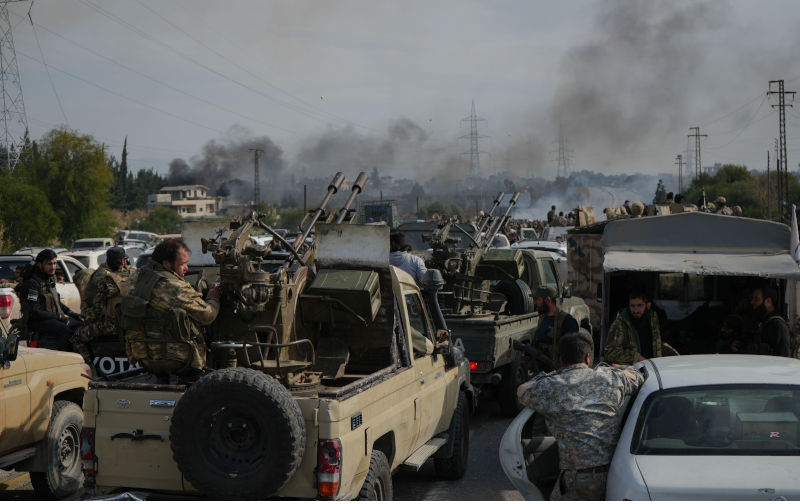The residents of the Syrian village of Sharifa lay in puddles and rivulets of blood. Some died with arms outstretched; others seemed to clutch protectively at their chests. Most had been executed with shots to the head and two women had their faces blown apart.
An acquaintance who grew up in Sharifa sent me the names of the victims – 22 men and five women. They were mostly elderly. He also sent photos and videos of their corpses. His 75-year-old father, a retired schoolteacher, was among the dead and he wanted people outside Syria to know what had happened.
The killings took place on 6 March by fighters linked to Syria’s “interim government” headed by Ahmed Sharaa, a former Islamic State and al-Qaeda operative now being rebranded in the West as an inclusive democrat.
Sharaa appointed himself “interim president” following the fall of the Assad regime in December and promised to hold elections “in four or five years”.
In early March, Sharaa ordered a military offensive to “restore order” to Syria’s northern coast, where followers of the Alawite religion (and, to a lesser extent, Shia Muslims and Christians) have endured months of persecution. There has been widespread kidnapping, murder and looting by soldiers and thugs loyal to Sharaa’s hardline Sunni Islamist regime.
Sharifa is a farming community near the town of Haffah, in the governorate of Latakia, about 30km from the Mediterranean. In better times, foreign tourists visited the district to see the imposing medieval castle of Saladin, which straddles a ridge between two deep ravines.
My acquaintance, a Syrian state employee in a non-political job, told me the approach of jihadist gunmen on 6 March caused panic among Sharifa residents, who were “unarmed and defenceless”.
“Younger people ran away into the fields but the old people stayed,” he said. “We thought they would hurt the young and not trouble the old. But they came into the house and dragged my father outside. When my mother asked where they were taking him, they said, ‘Stay in the house or we will kill you’.”
His father was taken to the village square and executed.
By 10 March, Sharifa had run out of food. The mukhtar or village head and two companions got permission from representatives of Hayat Tahrir al-Sham, Sharaa’s jihadist coalition, to drive to Haffah to buy bread
“On their way they ran into armed men,” my contact said. “The armed men asked them to identify themselves and they did. They were executed on the spot. Now, thousands of villagers are hiding in the fields with no food or water.”
He emphasised that the attack on Sharifa was unprovoked. “There had been no trouble or fighting in Sharifa. The people had no weapons. They were attacked because they were Alawi – no other reason.”
The Alawi, a syncretic, liberal branch of Shia Islam, make up 10% to 12% of Syria’s population. Syria’s new rulers regard them as apostates and they have been the targets of sectarian violence since HTS seized power in December.
Most Alawi lost access to weapons when Assad’s army commanders surrendered to HTS in return for a promised amnesty. However, it seems some Alawite former soldiers regrouped to ambush HTS fighters. The jihadist response was savage.
As The Economist reported, “Clerics in Idlib, the province previously ruled by Mr Sharaa and Hayat Tahrir al-Sham, his Islamist militia, called for a mass mobilisation in defence of the homeland. Some issued appeals for jihad from their mosques. The director of a Damascus radio station appointed by Mr Sharaa encouraged listeners to turn on Syria’s Alawites, saying they should be cast into the sea: ‘Far be it to say that we left the fish in the Mediterranean Sea hungry’. Thousands answered the call. Lines of traffic descended upon the largely Alawite coastal areas to attack those living there.”
As of 11 March, Alawi and others were still being slaughtered across Syria’s northwest, including the governorates of Latakia and Tartous and stretching eastward into Hama and Homs. Evidence is being compiled by social media sites and the death toll may run into the thousands.
Bigotry was always a powerful feature of opposition to Assad’s rule; anti-government protestors chanted “Alawis to the grave and Christians to Beirut!” from the start of the conflict in 2011.
We know bigotry is driving the latest slaughter because the jihadists who record and boast of their exploits say so – and because they have even targeted opponents of the former Assad regime on purely religious grounds.
The Economist summed up the carnage this way: “Since March 6th Sunni fighters have rampaged through heartlands of the Alawites, the ethnic group which the Assads, and many regime loyalists, came from. The fighters have torched homes and killed indiscriminately: in villages near the city of Latakia, they filmed themselves wearing masks and climbing on the backs of men, making them bark like dogs before shooting them dead. Eyewitnesses describe streets strewn with bodies and rows of burnt-out homes.”
HTS troops have used tanks, artillery, helicopters and drones against Alawi communities causing hundreds of thousands to seek refuge in the hills, forests, and even Russia’s Hmeimim Air Base in Latakia.
Alawi have borne the brunt of the assault, but Christians have also been targeted. Syria’s patriarchs have denounced attacks on innocent civilians, including women and children.
Sharaa’s administration did nothing to call off thousands of their armed supporters who flooded into the Alawi regions. Government ministers publicly mourned slain security forces, not civilians, and even warned their fighters against sharing incriminating videos.
Western human rights “watchdogs” have been unusually quiet on Syria since the fall of Assad. Human Rights Watch, always quick to amplify claims about Assad regime wrongdoing, had said nothing about the anti-Alawi terror campaign as of 11 March.
Much of the Western media, including Australia’s ABC, parroted the new regime’s claim that “pro-Assad gunmen” who fought back against sectarian killings were responsible for the violence. The European Union likewise blamed “pro-Assad elements”(it had already embraced HTS by lifting punishing sanctions imposed on the Syrian population under Assad).
The Trump administration was more forthright. Secretary of State Marco Rubio condemned “the radical Islamist terrorists, including foreign jihadis, that murdered people in western Syria in recent days”. He added, “Syria’s interim authorities must hold the perpetrators of these massacres against Syria’s minority communities accountable.”
This was grimly ironic given that an official in the first Trump administration described HTS as an “asset” to US strategy when the Americans worked to overthrow Assad.
The views expressed are solely those of the author and may or may not reflect those of Pearls and Irritations.

Chris Ray
Chris Ray is a freelance journalist whose writing on the Syrian war has appeared in Australian, US and UK publications.
